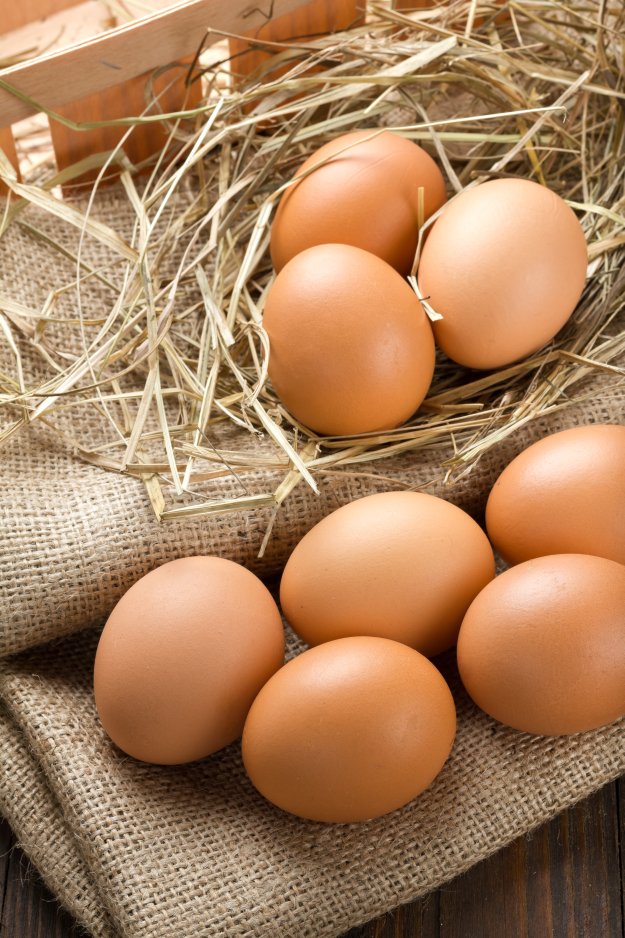Want to start raising chickens for eggs? Learn the homestead tips to raising the best egg laying hens that will be happy and healthy. Learn what to look for and what to avoid here in our homestead handbook.
You are reading Chapter 6 of our Homestead Handbook:
Raising Backyard Chickens
Chapter 6:
Raising Chickens For Eggs
Just as a woman is born with all the ovaries they can possess in their lifetime, female chicken also carry all the undeveloped yolks by the time they are born though they all will not become eggs. A hen can make several eggs a day which is the ideal thing for breeders who raise them for that purpose. Regardless, a chicken lays only a fraction of the total percentage of the eggs they start out with. It helps to understand the lifecycle of an egg from the beginning for most breeders keen on enhancing healthy eggs often.
6.1 – Egg Formation
A pullets’ (young chicken) life starts begins with two ovaries where only one side grows to be functional. This ‘good’ side is what holds all the undeveloped yolk that range in various sizes. Once the pullet is a few weeks old, it reaches the age it can lay they start to release a yolk every day. This process is known as ovulation and takes place within an hour following the last egg that was laid. Eggs are made quickly and take about 24 hours to develop. “Laying” is simply a cycle a hen goes through when it releases a group of eggs. Excellent layers are often heavy and can release fifty to eighty eggs during each cycle. Leghorns have the potential to make more than an egg a day without break totally to about 364-380 eggs in a year. The Red Sex Links can lay up to 300 eggs a year and the Black Star averages 250 eggs a year. Temperate light are two big factors involved in laying for chicken. The best temperature ranges between 43-78 degrees Fahrenheit. Anything lower than that results in decreased production. Though winter is known to be a period for colder climates, the true reason laying is slowed during this season is from shorter daylight hours.

The size of a chicken’s egg is often congruent to their age, so the older they are in age, the bigger their eggs will be. The type of breed they are and how much they weigh are also other influences. Eggs are categorized into six sizes: pee wee, small, medium, large, extra large and jumbo. If a larger bird lays smaller than expected eggs, it is not normal, and the cause should be looked into. It could be because they are temporally suffering from a poor diet, heat stress or lowered intake of salt and protein. Of the 24 hours it takes for an egg to be made, 20 hours of that time is spent enclosing the eggs within a shell. The color of an egg is decided during the time of formation. You will see hens with white earlobes lay white eggs, and the eggs of a chicken with red lobes are colored brown. The Crevecoeur, Dorking, Redcap and Sumantra, however, are red lobes that are exceptions to the rules and lay egg shells that are white. There are other egg colors that can be a tinted pink, green, blue, or red. The Copper Maran, for example, is a bird that lays the more rare colored eggs like red.
6.2 – Controlling the Environment
Eggs are naturally hatched during the springtime when there is plenty of sunlight. Chicks mature during the autumn or summer or summer seasons when there are fewer periods of light in the day. This goes on and on the same time each year and many breeders look for tricks to work around it to produce more eggs. You can get eggs during the winter – all you need to do is convince your hen into believing they are in the favorable season of daylight. Naturally daylight lasts for about fifteen hours until around fall. You can use artificial light until the spring when light is out for 15 hours each day again. It is important to remember to use the lights every day without fail because even a day’s lapse may get your hen to stop laying. I’m not the best with remembering a lot of things even when they are important, so I often use timers to remind me. If you walk around with your phone 24/7 like me, you can easily set them on your phone and never have to worry about missing a beat on anything. If for some reason that still doesn’t work for you, there’s also keeping your lights on all day but it is wasteful. Not only may your electricity bill increase, you’ll start to see your hen spend more of their time huddling indoors doing all types of mischief. There is no “night” to them so they will spend no real time resting which isn’t good for them physically as well. Many who are looking to increase the number of eggs their chicken can lay. Look for ways to discourage hens to brood, or hatch their eggs. Several good methods to avoid brooding would be to not let eggs accumulate in nests, inhibit access to the nest so the hen can’t get to it, physically removing the hen from the nest and to a separate housing,
6.3 – Looking for “Bad” Eggs
Unfortunately, not all the eggs that are produced will be used. Many of them may just not be up to par with quality such as texture, strength or shell color. Other factors include the egg possessing inadequate nutrition or are infested with parasites or disease. Eggs provide clues in detecting several physical or cognitive challenges in your layer. Eggs that appear bloody are often due to young chicken laying before their body is physically able and their tissue tear. It could also be from excess protein or coccidiosis that causes the intestines to bleed. Thin eggs are a result of pullets laying too early as well. Healthy eggs should be a particular shape and may be rounded, pointed or blunt depending on the breed. If you see an egg shell that has a glassy or chalky appearance to it, it may be a malfunction on the hen’s shell making. This type is safe enough to eat, but it will never be the kind that can hatch due to its low porosity. Wrinkled or oddly shaped eggs can happen from careless manhandling practices or a genetic error during the time of ovulation. Soft shells or eggs that are not layered in a shell completely are from stress or nutritionally induced. Some external factor can cause a hen to release the egg prematurely. Vitamin D and calcium are important for the chicken to take because they are bone and shell builders as well as strengtheners. A lack in these two can transfer to the egg visibly. If you take noticed that your chicken is producing fewer eggs than it is supposed to that isn’t related to improper nutrition, low temperatures or dehydration you may want to look into the possibility that they may have contracted a disease. If it is a viral infection, other symptoms include thin shells, depression, restlessness, weight loss and watery whites.

Eggs that are laid on the floor over the nest are usually by pullets that are new to the egg laying business. These eggs often are cracked open and dirty, so they are not safe to ingest. Most of these eggs were potentially good eggs, so the best way to prevent them from being on the floor is to make nests early for the young hen prior to the laying period. Placing an egg in a nest for a pullet to see is also good practice to get them to lay their eggs in a proper area and away from the floor. They appear safe to the young chicken and increases the likelihood they will continue to place their eggs in nests in the future. That way, they will not hide their eggs in various spaces that aren’t proper. Eggs should be in a clean environment to ensure they stay clean until it is time to collect them. It is tempting to wash eggs before you gather them, but doing that removes of the protective outer layer that seals in moisture and prevents bacteria from entering. As long as the hens have adequate space between one another and the nests are not in a dirty condition then you are in business – Mother Nature takes care of the rest. If the outer layer of an egg gets dirty, the culprit is likely from the mud on a chicken’s foot. Use methods that ensure it is not a recurring situation by locating the source, cleaning it and redesign where you are placing the nests. Keep the floor from getting damp and move the nest a few inches above the floor.
Good space is also good to have because of the high and low ranks that chicken have. Lower ranks will move about to hide their eggs if they are in a place that is overcrowded. Keeping nests clean now doesn’t need to be messy as long as you upkeep it. Nests should be lined with straw, shavings or shredded paper. It is also a wonder cushion for them and keeps them from cracking. A good inexpensive way to clean out a nest is to use a good cardboard, so that covers the bottom of each nest. Then fold another part of the cardboard over the top of the nest to remove any debris easily. Cardboard should regularly be replaced as chicken do pick at it, and it will eventually get worn out. If you have the expenses, a nest pad is a good option, and it is made to relive messy jobs from happening in the first place.
That was Chapter 6: Raising Chickens For Eggs from our Homestead Handbook: Raising Backyard Chickens

Leave a Reply